Home
The Advantages of Choosing Outdoor Tiles Over Concrete

When it comes to designing outdoor spaces, the choice of flooring material is a critical decision that can significantly impact both the aesthetics and functionality of the area. Two common options are outdoor tiles and concrete. While concrete has long been a popular choice for its durability and cost-effectiveness, outdoor tiles offer several advantages that make them an increasingly favored option among homeowners and designers.
7 Key Advantages Of Outdoor Tiles Over Concrete
1. Aesthetic Versatility
Outdoor tiles come in a wide variety of colors, patterns, and textures, allowing for greater creative freedom in design. Whether you prefer the rustic charm of natural stone, the sleek look of porcelain, or the vibrant patterns of ceramic, there is an outdoor tile to match your vision. In contrast, concrete tends to have a more uniform and utilitarian appearance, which can be limiting if you are aiming for a specific aesthetic.
2. Enhanced Durability
Modern outdoor tiles, particularly those made from porcelain or natural stone, are engineered to withstand harsh weather conditions, heavy foot traffic, and other outdoor challenges. These tiles are often resistant to cracking, fading, and staining, which can be common issues with concrete. Additionally, many outdoor tiles are designed to be non-slip, providing a safer surface for walking, especially in wet conditions.
3. Low Maintenance
Outdoor tiles are generally easier to clean and maintain compared to concrete. Spills and stains can be quickly wiped away from tiles without leaving marks, and routine cleaning typically involves just sweeping and occasional mopping. Concrete, on the other hand, is porous and can absorb stains more easily, often requiring more intensive cleaning methods and sealing to maintain its appearance over time.
4. Temperature Regulation
Concrete can become extremely hot under direct sunlight, making it uncomfortable to walk on during the summer months. Outdoor tiles, especially those made from natural materials like stone, tend to stay cooler and provide a more comfortable surface. This temperature regulation can enhance the usability of your outdoor space, making it more enjoyable during hot weather.
5. Environmental Benefits
Choosing outdoor tiles, particularly those made from natural or recycled materials, can be a more environmentally friendly option compared to concrete. Many outdoor tiles are produced with sustainable practices and materials, reducing their environmental footprint. Additionally, tiles can often be removed and reused, whereas concrete demolition can generate significant waste.
6. Installation Flexibility
Outdoor tiles offer greater flexibility in installation compared to concrete. They can be installed over a variety of surfaces, including existing concrete, which can save time and labor costs. This adaptability allows for easier updates and renovations, enabling homeowners to change their outdoor flooring with less hassle than removing and replacing concrete.
7. Increased Property Value
The aesthetic appeal and functional benefits of outdoor tiles can enhance the overall value of your property. Well-chosen tiles can create a luxurious and inviting outdoor space that can attract potential buyers and boost the marketability of your home. In contrast, concrete, while durable, may not have the same visual impact and appeal.
Conclusion
While concrete remains a practical choice for outdoor flooring, the advantages of outdoor tiles are hard to overlook. From their aesthetic versatility and enhanced durability to their low maintenance requirements and environmental benefits, outdoor tiles provide a superior alternative that can transform your outdoor spaces into beautiful, functional, and inviting areas.
Whether you are renovating your patio, creating a garden path, or designing a pool deck, outdoor tiles offer the perfect blend of form and function, making them a worthwhile investment for any homeowner.

